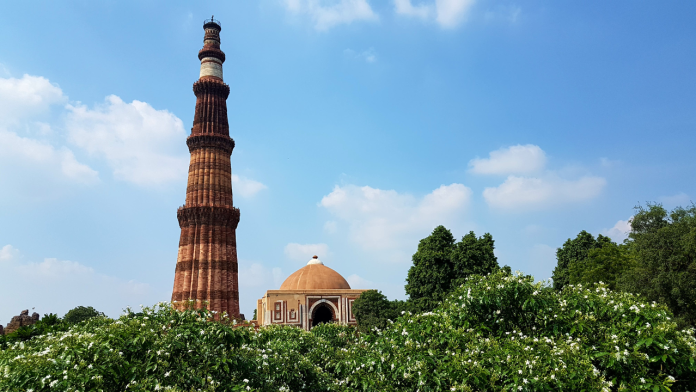Explore the rich history and captivating beauty of the Architecture of Delhi Sultanate in this in-depth journey through time.
Introduction
The architecture of the Delhi Sultanate is a remarkable testament to the cultural fusion and artistic brilliance that emerged during the medieval period in India. This article delves into the intricacies of Delhi Sultanate architecture, a historical narrative that seamlessly blends influences from diverse sources.
Early Influences on Delhi Sultanate Architecture
The roots of Delhi Sultanate architecture can be traced back to the early Islamic architecture of Persia, Central Asia, and the indigenous Hindu and Jain traditions of India. These diverse influences contributed to the formation of a unique architectural style that represented the syncretism of the era.
Indo-Islamic Fusion: The Synthesis of Styles
Architecture of Delhi Sultanate is distinguished by the harmonious coexistence of Hindu and Islamic architectural elements. The use of intricate calligraphy, geometric patterns, and domes was combined with traditional Indian features like arches, pillars, and spires. This fusion created a distinct architectural language that resonates even today.
The Grandeur of Mosque Architecture
Mosques built during the Delhi Sultanate era exhibit a grandeur that is awe-inspiring. The Quwwat-ul-Islam Mosque, a UNESCO World Heritage Site, showcases the early mastery of Indo-Islamic architecture. Its majestic columns and ornate domes set a precedent for future mosque designs.
Magnificent Forts and Palaces
The sultans of the Delhi Sultanate constructed grand forts and palaces as symbols of power and authority. The Red Fort, a UNESCO World Heritage Site, is a prime example. Its red sandstone walls and ornate gateways offer a glimpse into the opulence of the Mughal era.
Mausoleums and Tombs: A Glimpse into the Afterlife
Architecture of Delhi Sultanate’s excellence extends to its mausoleums and tombs. The Qutb Complex features the iconic Qutub Minar, a towering example of Indo-Islamic architecture. Tombs like that of Iltutmish showcase intricate carvings and delicate ornamentation.
Intricate Minarets and Calligraphy
Architecture of Delhi Sultanate often boasted tall, slender minarets adorned with intricate calligraphy. The Alai Minar, though unfinished, reflects the innovation of its time with its imposing height and graceful designs.
The Resilience of Delhi Sultanate Architecture
Despite the passage of centuries, many architectural marvels from the Delhi Sultanate era still stand tall, defying the test of time and nature. Their resilience and architectural beauty continue to attract tourists and historians alike.
Preservation Efforts: Safeguarding The Architecture of Delhi Sultanate
Preserving the architectural wonders of the Delhi Sultanate is of paramount importance to ensure that future generations can continue to marvel at these historical treasures. Several initiatives and organizations are dedicated to the restoration and maintenance of these architectural gems.
Conservation Techniques
To maintain the integrity of these ancient structures, experts employ conservation techniques that balance the need for structural stability with historical authenticity. These techniques include careful cleaning, repairs, and using materials that match the original ones as closely as possible.
UNESCO World Heritage Sites
Many of the significant architecture of Delhi Sultanate have earned recognition as UNESCO World Heritage Sites. This global acknowledgment helps secure international support and funding for their preservation and restoration.
Public Awareness
Educating the public about the cultural and historical significance of Delhi Sultanate architecture is crucial. Museums and visitor centers near these sites play a vital role in creating awareness and appreciation among visitors.
Community Involvement
Engaging local communities in the preservation efforts fosters a sense of ownership and pride. Involving the people living near these historical sites can lead to better protection and sustainable tourism practices.
The relentless efforts to safeguard the architectural heritage of the Delhi Sultanate are not only a tribute to the past but also a commitment to the future, ensuring that these treasures remain accessible for generations to come.
Impact and Legacy
The architecture of the Delhi Sultanate left an indelible mark on Indian history. It influenced subsequent architectural styles, including the Mughal and Deccani styles, and continues to inspire contemporary architects.
Conclusion
Architecture of Delhi Sultanate represents a glorious blend of cultures and artistic expression. Its enduring legacy is a testament to the creative genius of a bygone era, and the architectural wonders of this period stand as living testaments to the rich tapestry of India’s past.
FAQs
- What are the key features of Delhi Sultanate architecture? Architecture of Delhi Sultanate combines Islamic and Indian elements, featuring intricate calligraphy, arches, domes, and spires.
- Who were the prominent architects of the Delhi Sultanate era? Prominent architects include Qutb-ud-din Aibak, Alauddin Khalji, and Feroz Shah Tughlaq.
- How did the architecture of Delhi Sultanate evolve over time? It evolved through the synthesis of diverse influences, resulting in a unique Indo-Islamic style.
- What are some must-visit architectural wonders from the Delhi Sultanate period? Notable sites include the Qutb Complex, Red Fort, and the Alai Darwaza.
- Can you explain the fusion of Hindu and Islamic elements in Delhi Sultanate architecture? Delhi Sultanate architecture seamlessly blends features like arches, pillars, and spires from Indian traditions with Islamic elements like calligraphy and domes, creating a unique synthesis.



